From the October 1976 issue of Monthly Film Bulletin (vol. 43, no. 513.
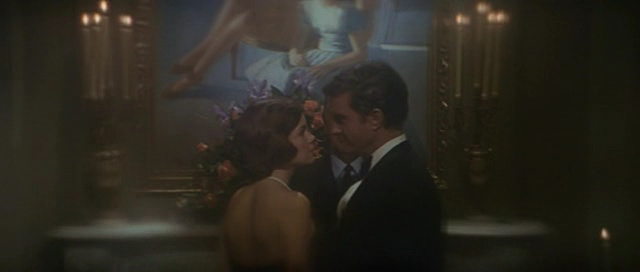
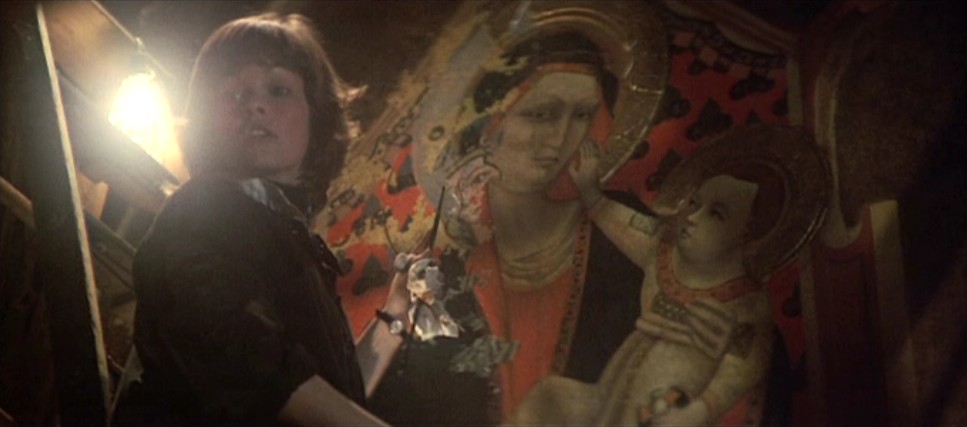
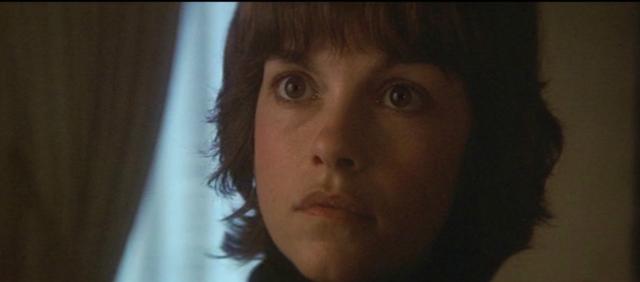
Obsession
U.S.A., 1976
Director: Brian De Palma
Pondering over her restoration work in a Florence cathedral, Sandra (Geneviève Bujold) wonders aloud to Michael (Cliff Robertson) whether she should risk removing a painting’s surface to see what lies beneath it, or else restore only the first layer. “Hold on to it”, Michael replies, giving voice not only to his surface obsession but to De Palma’s cool strategy –- to reconstruct or “restore” the mood and manner of Hitchcock’s Vertigo some eighteen years after the fact without worrying too much about the reasons or impulses underlying them. An effective variant on the director’s earlier Sisters — with mother and daughter taking over the symmetrical “mirror” pattern formerly established by Siamese twins, and diverse echoes of Vertigo, Rebecca, Dial M for Murder, and Marnie assuming much the same function here as Rear Window and Psycho did in the earlier film — Obsession also resurrects some of Hitchcock’s most visible characteristics (tight plot construction, extended doppelgänger effects, precise control of point-of-view) while blithely neglecting others (above all, humor and a consistent moral position). What results is a lot closer to the pure engineering of a Spielberg or a Friedkin than to the “personal” nostalgia of a Truffaut or a Bogdanovich, revealing a cleanly constructed mechanism whose limitations are merely the reverse of its expediency (as in the outlandishly contrived scene where Robert improbably exposes his deceptions to Michael, a move dictated more by the spectator’s needs than those of either character). Read more
This appeared in the January 23, 1997 issue of the Chicago Reader. — J.R.

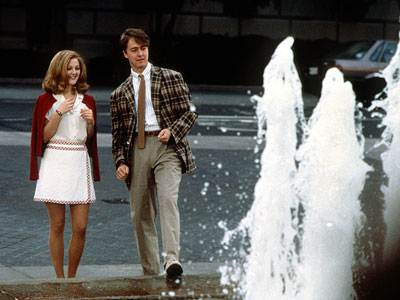
Mother
Rating *** A must see
Directed by Albert Brooks
Written by Brooks and Monica Johnson
With Brooks, Debbie Reynolds, Rob Morrow, Lisa Kudrow, Isabel Glasser, and Peter White.
Everyone Says I Love You
Rating * Has redeeming facet
Directed and written by Woody Allen
With Allen, Goldie Hawn, Edward Norton, Alan Alda, Julia Roberts, Drew Barrymore, Lukas Haas, Gaby Hoffmann, Natasha Lyonne, Natalie Portman, Tim Roth, and David Ogden Stiers.
Everyone who’s grown up with Hollywood movies has a different tolerance for their lies and comforts, their snares and temptations — and that tolerance changes as we grow older. A fantasy that’s easy to swallow when we’re young might seem pernicious after we discover its falsity, though later it may be cherished as a memento of our former innocence and capacity to believe. But for some individuals the rude awakening is so severe that it becomes impossible to encounter a particular Hollywood fantasy again without wincing. How we respond is a consequence of what Hollywood once did to our susceptibilities — whether it made our lives happier or unhappier, offered guidance or misguidance, solace or trauma. Read more

Harry d’Abbadie d’Arrast (1897-1968) made eight films, all between 1927 and 1935, and apparently some of these are lost. (He was fired from the early talkie Raffles — which seems to retain a few d’Arrastian qualities — and replaced by George Fitzmaurice, and reportedly he also did some uncredited work on Wings.) I’ve seen three of his films — the two briefly described below (both for the 2009 catalogue of Il Cinema Ritrovato in Bologna) and Topaze (1933) — and all of them are pretty remarkable. (The latter is a Pagnol adaptation with one of John Barrymore’s most touching performances.) As far as I know, the only one who ever wrote about this figure in any detail was Herman G. Weinberg in Saint Cinema. According to Pierre Rissient, who knows a lot about d’Arrast (and passionately denies that he was antisemitic — a gossipy accusation I’ve sometimes heard about him, presumably as a partial explanation for why he fought as often as he did with producers), d’Arrast also had a lot to do with the preparation of one of my favorite musicals, Hallelujah, I’m a Bum! (1933), which wound up being directed by Lewis Milestone.
The following capsules were written for the catalogue of Il Cinema Ritrovato in June 2009. Read more
From the Chicago Reader (August 6, 1999). — J.R.
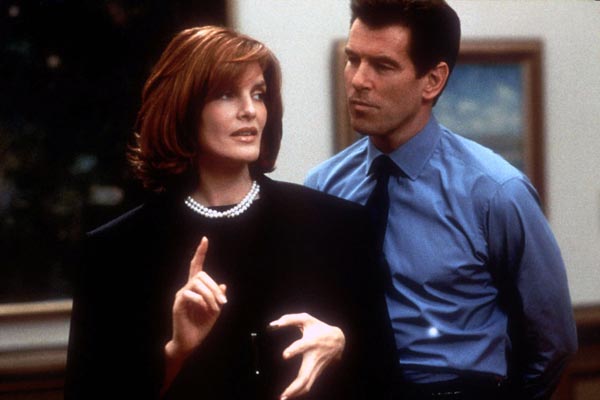
The Thomas Crown Affair
Rating ** Worth seeing
Directed by John McTiernan
Written by Alan R. Trustman, Leslie Dixon, and Kurt Wimmer
With Pierce Brosnan, Rene Russo, Denis Leary, Frankie R. Faison, and Faye Dunaway.
By Jonathan Rosenbaum
Seeing an original movie and its remake in reverse order is a bit like reading a novel (as opposed to a novelization) after you’ve seen the movie. It usually distorts your sense of priorities, forcing you to see the ideas and images of the original in terms of the remake. That’s why I suspect I’ll never know whether the remake of The Thomas Crown Affair is inferior to the 1968 original. Both are entertaining pieces of trash, but look at them in succession — in either order — and they start to undermine each other.
Both are about a classy investigator for an insurance company (Faye Dunaway in 1968, Rene Russo in 1999) going after a debonair zillionaire (Steve McQueen then, Pierce Brosnan now) who pulls off elaborately planned, outrageous robberies with hired helpers just for the fun of it. In the original, set in Boston, he robs a bank; in the remake he steals a Monet from New York’s Metropolitan Museum and then, just to show how cool he is, replaces it without getting caught. Read more
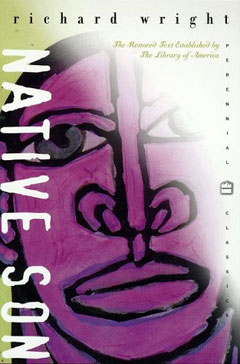
Political incorrectness has a lot to do with what still gives this novel much of its shocking power: the fact that Richard Wright refuses to make Bigger Thomas sympathetic or his crimes in any way excusable, even though he understands perfectly and very cogently how and why this character can murder as readily as he does— not only a white philanthropist’s daughter, whom he accidentally smothers, but also Bigger’s own girlfriend, whom he kills with a brick quite deliberately, almost immediately after they have sex. Recently reading this 1940 Chicago novel for the second time, I was reminded of both Dostoevsky and Camus (even though, novelistically speaking, Wright is miles ahead of L’Étranger). There’s something schizophrenic as well as dialectical about the way Wright can grasp the thought processes of his primitive young hero and then can offer a lengthy intellectual discourse about those processes. Eventually the communist discourse and arguments in the book’s second half drown out Bigger’s identity, but the way Bigger himself is allowed to dominate the discourse in the first half is the book’s unambiguous and terrifying triumph. Read more

I urge any Chicagoans reading this post to rush out and see this local stage production (and world premiere), the most exciting piece of theater I’ve ever seen in this city. But I’m sorry to say that the only illustration I can access on the Internet and reproduce here is the above image, which is what’s used in the ads. [Postscript, 2/9: Lara Goetsch, TimeLine’s director of marketing and communications, has subsequently sent me four of her own photos of the production; my two favorites are reproduced below.] This isn’t bad when it comes to dealing thematically with Masha Obolensky’s play (which is about the creative processes involved in playwriting—specifically, about the processes by which real-life playwright Sophie Treadwell turned the 1927 murder case and execution of Ruth Snyder into a very successful expressionist play, Machinal, produced on Broadway with Zita Johann and Clark Gable in 1928), which bears a certain relationship to David Cronenberg’s film of Naked Lunch. (Admittedly, Cronenberg’s politically incorrect and highly idiosyncratic adaptation of William S, Burroughs is a far cry from Obolensky’s feminist play when it comes to comes to sexual politics; but even so, what this play and this film does with typewriters as pivotal props in relation to transformations between real life and fiction does seem comparable.) Read more
From the Village Voice (February 28, 1974). -– J.R.

Theory of Film Practice
A book by Noël Burch
Praeger, $3.95 and $8.95
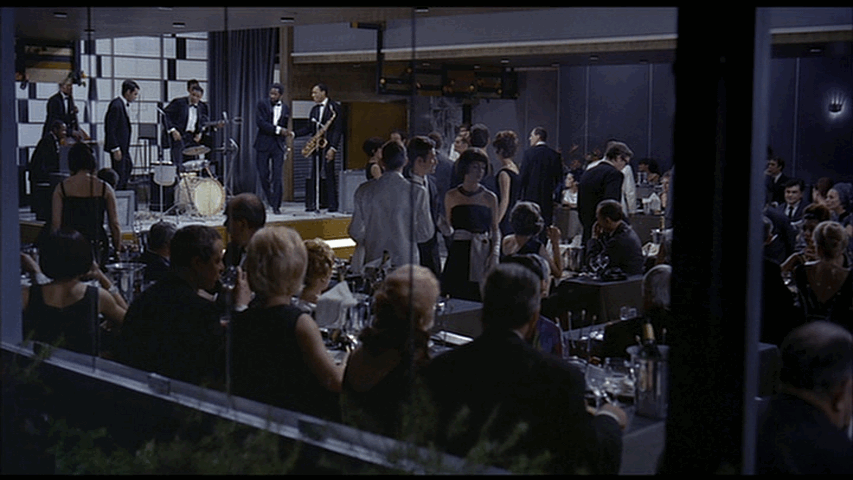
“These comments were written before the release of Tati’s ‘Playtime’. Even if they still hold true for films in general, they are not applicable to Tati’s film, the first in the history of cinema that not only must be seen several times, but also must be viewed from several different distances from the screen. In its form, it is probably the first truly ‘open’ film. Will it remain an isolated experiment? Masterpieces somehow eventually assert their authority and become models.”
— “Theory of Film Practice”
It seems oddly appropriate that “Theory of Film Practice” should appear in Cahiers du Cinéma that same year (1967) that “Playtime” opened in Paris, and also that they should arrive in America at approximately the same time. Films that re-define the language and syntax of cinema are rare in any period, and it is hardly surprising that books that do the same are even less common.
Both works, emerging out of years of reflection, stand defiantly apart from the surrounding landscape, inviting us to share that broad perspective. Each offers us a fresh garden of possibilities in the midst of a familiar terrain by drawing us into a kind of creative collaboration that requires, at least implicitly, that we become film makers. Read more
From the Chicago Reader (March 15, 1991). — J.R.
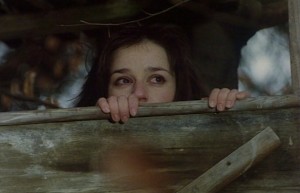
THE NASTY GIRL
** (Worth seeing)
Directed and written by Michael Verhoeven
With Lena Stolze, Monika Baumgartner, Michael Gahr, Fred Stillkrauth, Elisabeth Bertram, Robert Giggenbach, and Hans-Richard Muller.
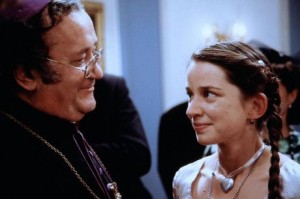
We’re told at the outset of Michael Verhoeven’s The Nasty Girl that Anja Rosmus inspired this film. What we aren’t told is who Rosmus is or how closely this film is based on what happened to her in the 1980s.
Born in 1960 and raised in the Bavarian city of Passau — where Adolf Hitler spent part of his childhood and where Adolf Eichmann was later married — Anja Elisabeth Rosmus, the daughter of two schoolteachers, had a comfortable, middle-class, Catholic upbringing. When she was 20, she won first prize in a national essay contest, writing about privacy and public freedom in European politics and history. The following year she entered another national essay contest, this time settling on a local topic: “An Example of Resistance and Persecution: Passau, 1933-1939.” Having been brought up to believe that her hometown was a bastion of resistance against the Nazis, largely through the efforts of the local Catholic church, she thought she was undertaking a project that would enhance local pride and was surprised by the defensiveness and hostility she encountered from certain quarters outside the church. Read more
From the Chicago Reader (May 18, 2001). — J.R.
The King Is Alive
*
Directed by Kristian Levring
Written by Levring and Anders Thomas Jensen
With Miles Anderson, Romane Bohringer, David Bradley, David Calder, Bruce Davison, Brion James, Peter Kubheka, Vusi Kunene, Jennifer Jason Leigh, Janet McTeer, Chris Walker, and Lia Williams.

The King Is Alive, directed and cowritten by Kristian Levring, is the fourth film to have the dubious honor of qualifying for certification under the rules of the Dogma 95 manifesto, whose professed aim is to get back to the basics of realism — shooting, for example, in natural locations with handheld cameras, direct sound, and natural lighting. But what’s basic or realistic and what isn’t, in terms of film history and technique? The manifesto also insists that movies be shot in color, a rather ahistorical reading of what’s basic — unless one labels all possible uses of color in film realistic and all possible uses of black and white artificial.
If that’s the operative assumption, The King Is Alive triumphantly refutes it. The movie was shot with three digital video cameras — unlike Thomas Vinterberg’s Dogma film The Celebration, which was shot with only one, and Lars von Trier’s Dancer in the Dark (not a Dogma film, but made by one of Dogma’s founders), which was shot with a hundred — and that might make it seem new as well as passé. Read more
From Monthly Film Bulletin, October 1975. — J.R.
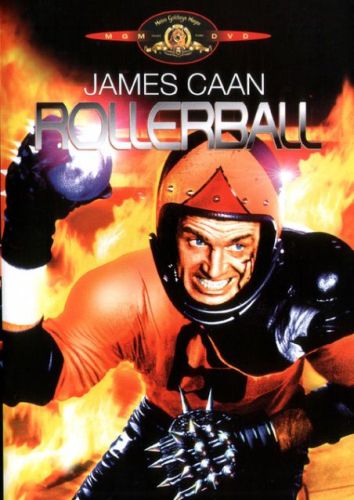
Rollerball
U.S.A., 1975 Director: Norman Jewison
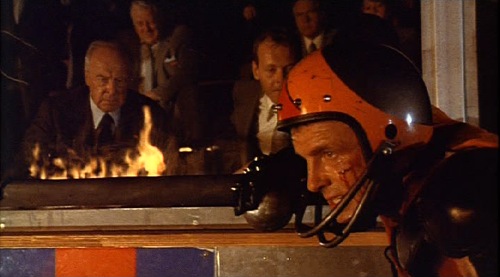
A classic demonstration of how several millions of dollars can be
unenjoyably wasted, Rollerball postulates an unlikely future society
from which war, poverty, illness and individual initiative have all
magically vanished, but then resolutely refuses to show it, reserving
all its heavy hardware for the brutal mechanics of an exceedingly
dull sport that is presumed to make this invisible anti-utopia
possible. Featuring a noble savage hero who stumbles clumsily
after an obscure mystery like a donkey running repeatedly into a
brick wall — James Caan reprising his performance in The Gambler
without the literary quotes, in a comparable embodiment of
mindless masochism-and a Sphinx-like villain (John Houseman)
who glowers occasionally to illustrate which side he’s on, this
glib fable seems to be aiming at a simplified version of A
Clockwork Orange without any intimations of wit or satire to
carry the vague moralistic message. Futuristic extrapolation, apart
from the central conceit, is mainly restricted to a couple of
streamlined buildings and the same lettering design recurring
whenever possible; humor, aside from an irreverent (if
implausible) scene with Ralph Richardson as a computer
librarian, usually figures only unintentionally, for instance
when Jonathan E is informed that Moonpie’s brain has ceased
to function — the first indication in the script that it has ever
functioned at all; the multi-track musical accompaniment
principally comprises an anthology of classical favorites
used in previous films.Notwithstanding Read more
From The Soho News (June 4, 1980). In the interests of full disclosure, I should note that Jackie Raynal was and is one of my dearest friends. — J.R.
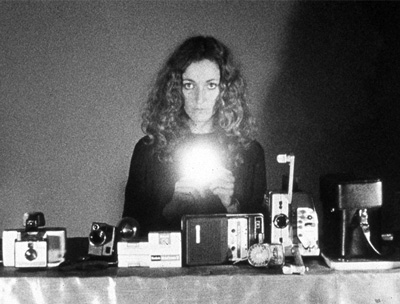
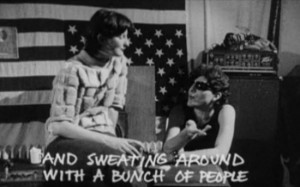
Deux Fois
A Film by Jackie Raynal
Bleecker Street Cinema, June 9
Debt Begins at Twenty
A Film by Stephanie Beroes
Millennium, May 24

Recalling my four successive visits to the Cannes Film Festival in the early ’70s — when the daily glut of movies and accompanying hardsell was already enough to turn a hardened film freak into a deflated beachball — I still harbor fond memories of the kind of movies that used to spend my days looking for, and the ones that would savor for days more, days on end, once I found them. They were movies that allowed me and Cannes to slow down and linger a bit and regain our strength, and afforded us that pleasure by refusing to hype us into or out of anything that denied either of us the solipsistic joy of total self-absorption.
By taking their own sweet time (all the time in the world) to explore their own bittersweet fantasies, and allowing us to follow them only if we insisted, these movies were like little self-contained oases conjured up and plunked down improbably in the midst of camel stampedes, which is probably why so many of my colleagues hated them — and why most of you, in turn, have heard of so few of them, if any at all. Read more
From the Chicago Reader (February 1, 1998); updated and upgraded in December 2012. — J.R.
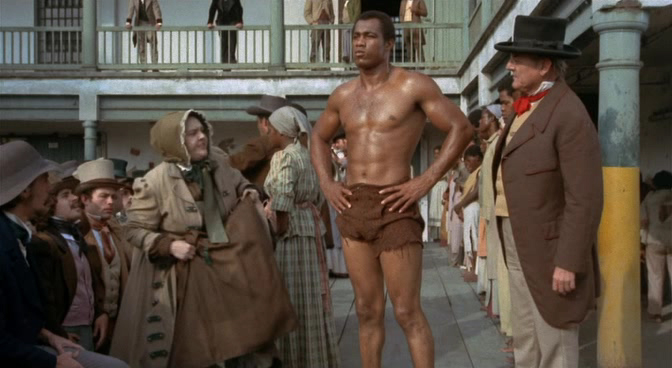
One of the most neglected and underrated Hollywood films of its era, Richard Fleischer’s blistering and undeniably lurid 1975 melodrama about a slave-breeding plantation in the Deep South, set in the 1840s, was widely and unjustly ridiculed as camp in this country when it came out. But apart from this film, Herbert J. Biberman’s 1969 Slaves, and Charles Burnett’s 1996 Nightjohn, it’s doubtful whether many more insightful and penetrating movies about American slavery exist. (2012 note: Quentin Tarantino’s thigh-slapping Django Unchained — a film so historically whimsical that it can show us a slave who’s an expert marksman, can read, and even puts on sunglasses after he becomes a free man — clearly isn’t one of them; at best it’s another Tarantino True Life Adventure for ten-year-old boys — ten-year-old girls need not apply.) Scripted by Norman Wexler from a sensationalist novel by Kyle Onstott; with James Mason, Susan George, Perry King, Richard Ward, Brenda Sykes, and Ken Norton. (For further and much more detailed edification on this subject, check out Robin Wood and Andrew Britton.) (JR)
 Read more
Read more
From the Chicago Reader (October 1, 1989). — J.R.

Joseph Losey’s black-and-white SF thriller, made in 1962 during his pre-Pinter British period, begins as a sort of love story — MacDonald Carey is an American businessman who shows interest in Shirley Anne Field and as a consequence gets beaten up by teddy boys led by Oliver Reed — then gradually turns into an antinuclear parable about radioactive children sequestered from humanity in an underground cave. Originally titled The Damned, the film was mangled by distributors but later restored for TV; more than an interesting curiosity, it’s one of Losey’s best English efforts, and Viveca Lindfors contributes a striking part as an eccentric sculptress. 96 min. (JR)
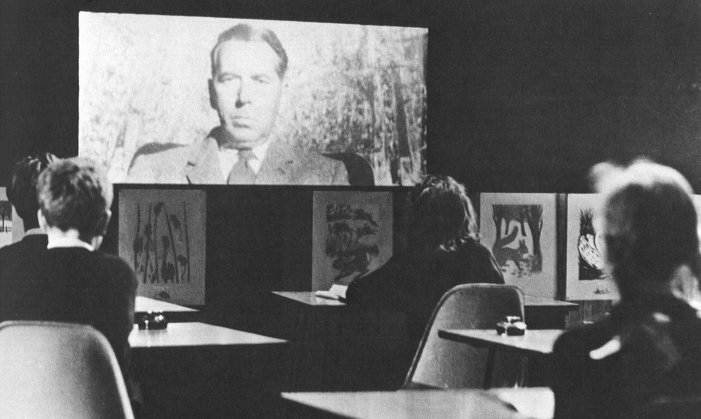 Read more
Read more
Written for Moving Image Source‘s “Moments of 2012”, posted January 10, 2013. — J.R.
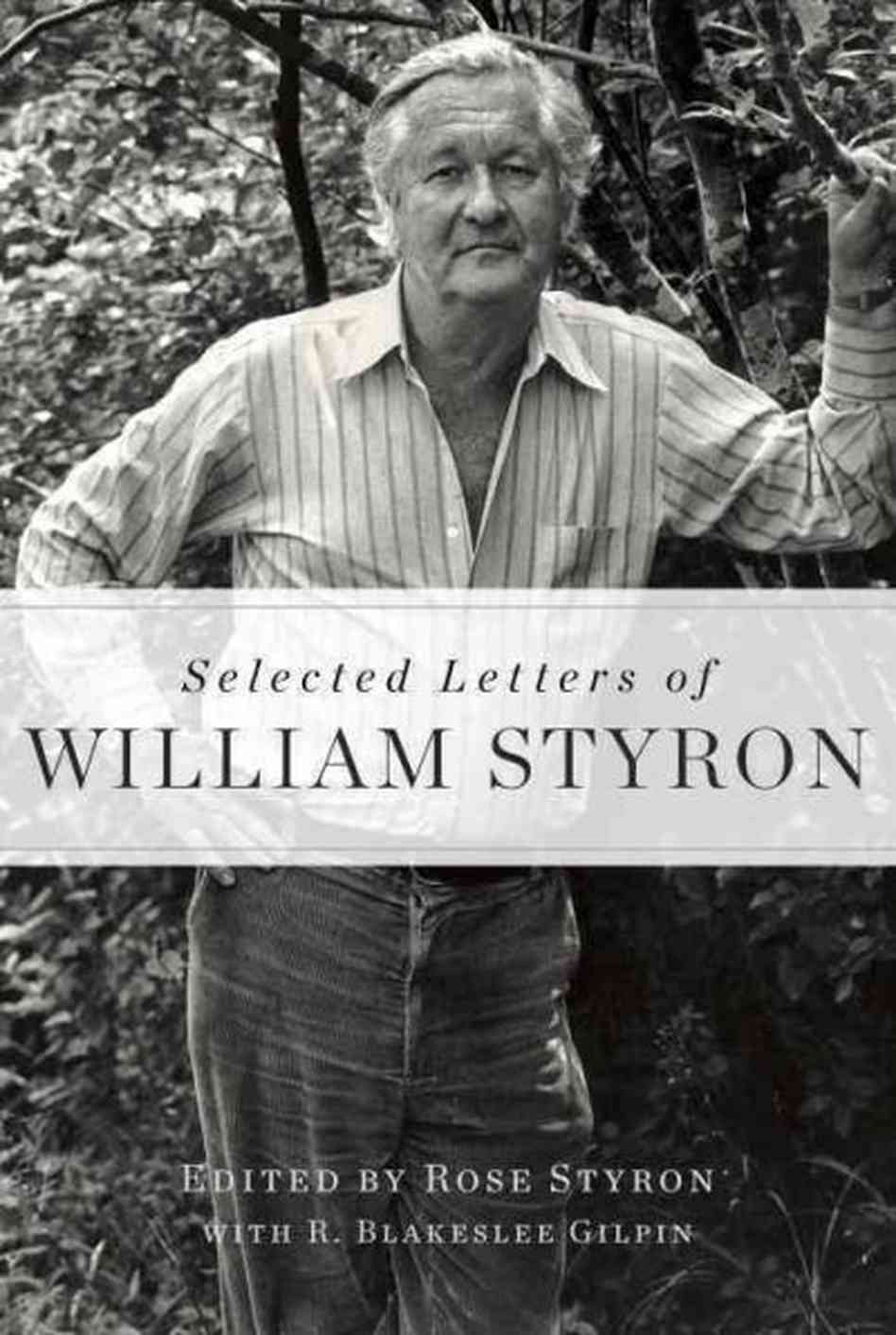
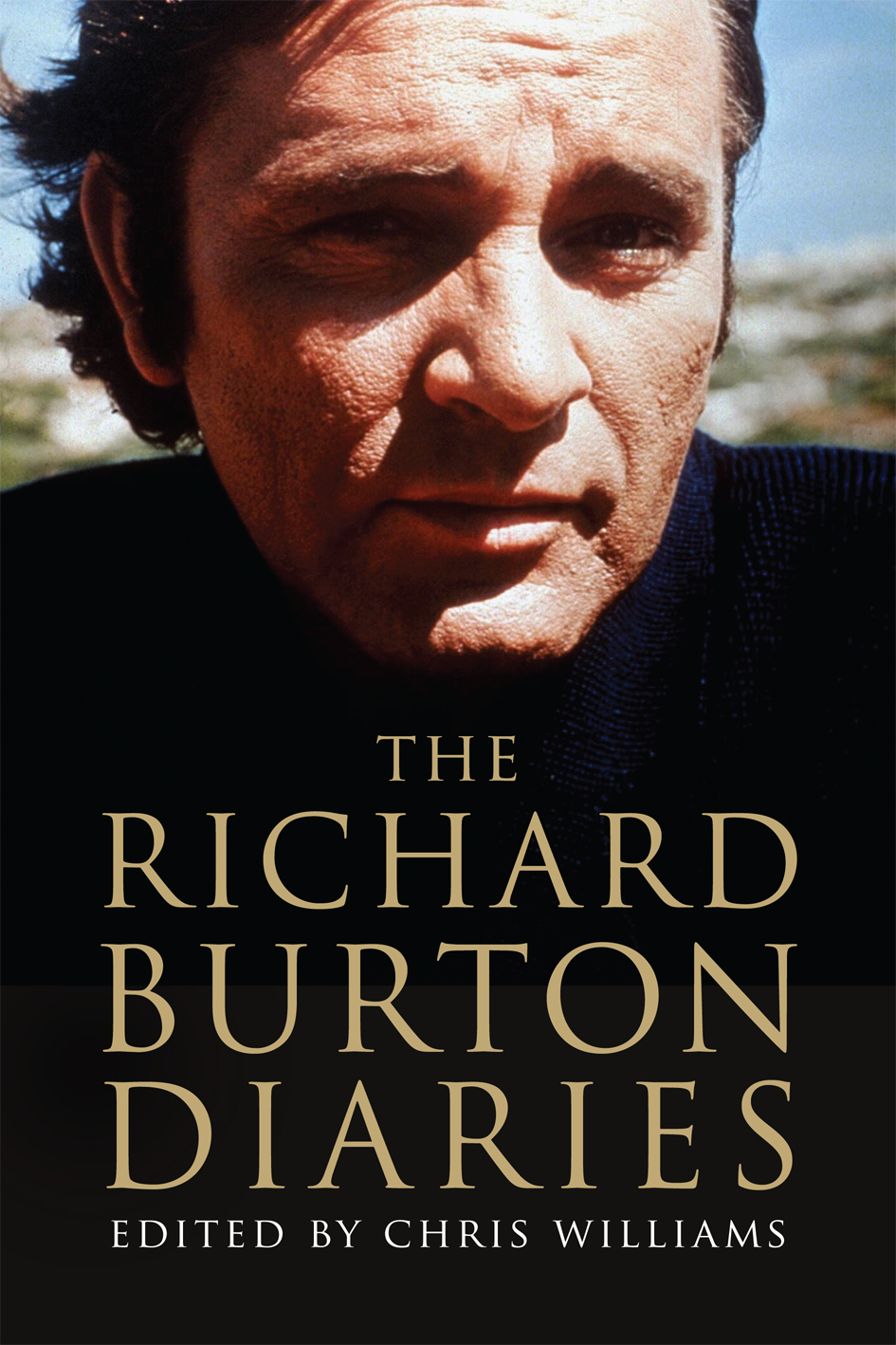
This holiday season, part of my light reading has consisted of browsing through two new doorstop-size books, each over 600 pages long, Selected Letters of William Styron and The Richard Burton Diaries. The differences between them have been both telling and surprising, at least to me. Both men were heavy drinkers and literary pontificaters who spent much of their social lives hanging out with celebrities, but Styron—the more prestigious and respectable of the two, and admittedly the one I respected more before broaching these two volumes — proves to be an utter, sanctimonious bore, seemingly more interested in career management than in life, while Burton, forever the shameless hack actor, has both an interest in life and a wry sort of humor about it that sparkles on every page.
Admittedly, there’s not necessarily much correlation between artistic talent and the way one communicates with one’s self or with friends, acquaintances, and relatives. My own semi-admiration for Styron stems mainly from what I remember favorably about Set This House on Fire and Sophie’s Choice — two of his less respectable efforts, according to this country’s literary tastemakers, but possibly more because of their perceived subject matter than because of their dramatic achievements. Read more
From the Chicago Reader (October 1, 1995); corrected and updated in September 2012. — J.R.
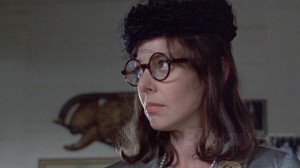
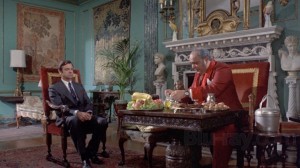
Writer-director-star Elaine May’s first feature (1971). Not all of it works, and the studio cut some of the darker elements (including a murder sequence that May avows was one of the funniest things Jack Weston ever did), but it’s still an often brilliant and frequently hilarious comedy. Walter Matthau, cast wildly against type, plays a spoiled playboy suddenly deprived of his wealth who plots to marry and murder a wealthy, klutzy, and clueless botanist (May, playing sort of a female Jerry Lewis). May’s savage take on her characters irresistibly recalls Stroheim; she’s at once tender and corrosive (as well as narcissistic and self-hating). This is painful comedy, to be sure, but there’s a lot of soul and spirit behind it. With James Coco, George Rose, and William Redfield. (JR)
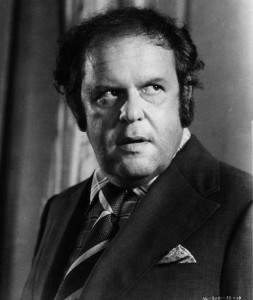 Read more
Read more




























